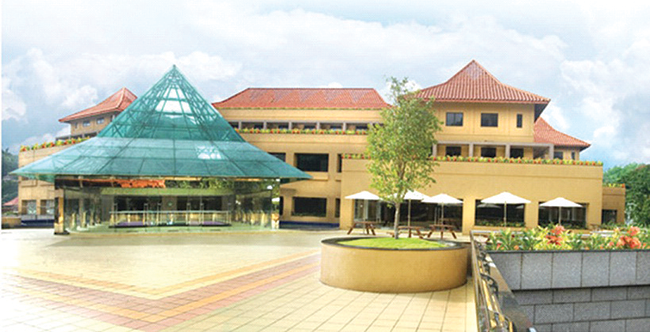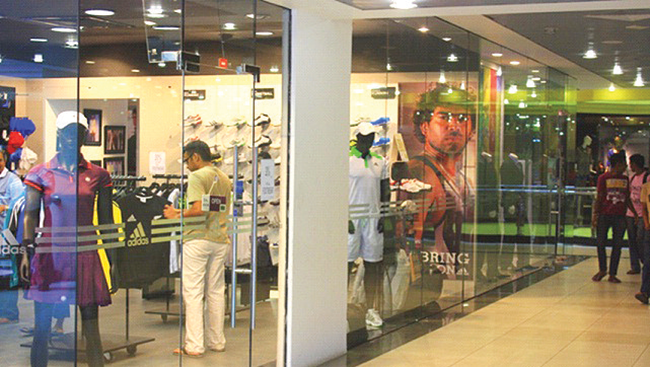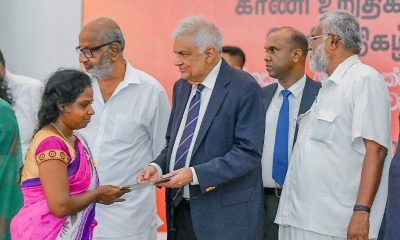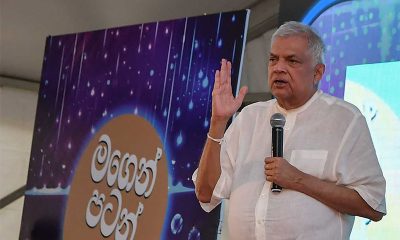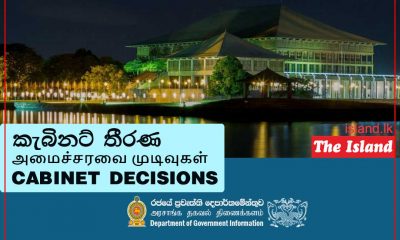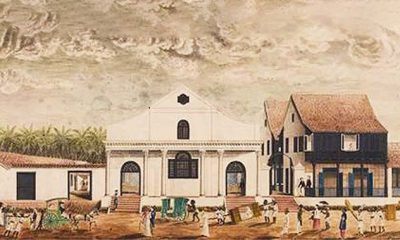Features
Master plan for sensitive area in Heritage City of Kandy
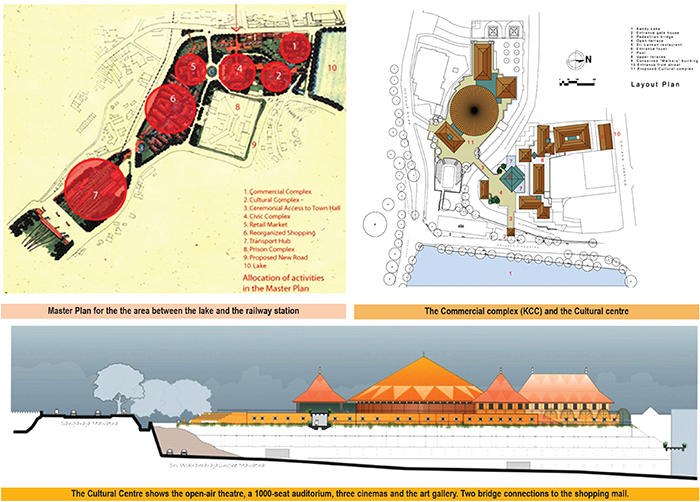
by Ashley de Vos
In 1994, the Department of Archaeology, The Central Cultural Fund and the Kandy Municipal Council held an open competition to develop a sensitive area in the heritage city of Kandy – the space between Bogambara Lake and the railway station. The competition was open for a specified time limit and Architect Geoffrey Bawa served as the jury’s Chairman.
The First prize in the open Master Plan competition was won by ADV Consultants. And the prize money of Rs. 300,000 was offered and of it Rs. 100,000 was received. For some reason, the UDA did not implement the original Master plan concept, as proposed in the Master plan. But some portions of the plan have been implemented intermittently, claiming to be others’ ideas.
There were some issues related to the Master plan that had to be respected and elucidated to arrive at a holistic concept for an important sensitive heritage city like Kandy. Our investigations showed Kandy has four problems: a high complement of buses parked on the roads, inadequate car parking in the city, the lack of a drainage system, and extra heavy development pressure on the inner city.
The first Visual pollution and impact on arrival in Kandy, is that it has been expanded to a great big bus stand. In the past, in the days of the bus depots, the vehicles retired to the depot for the night. However, under privatisation, the buses stayed on the roads, as close as possible to the stand, throughout the night, with the drivers and conductors sleeping in the bus. There had to be a drastic solution for the buses. The bus parking was unsightly, and a solution was found to change that. Is there a new location for the bus stand? There is no land available in the vicinity.
Could we create a Bus/Train transport terminal? The Railway Department owned about a couple hundred acres around the railway station, instead of looking for land and buying land rights. We, instead proposed a solution to buy air rights and raise the bus stand onto an elevated platform above the railway premises. Gopallawa and Peradeniya Mawatha could be easily reached from a raised platform. The bus stand would be raised on columns, and the railway could still function.
Commuters arriving by train would go up and take a bus, and those coming by bus could go down and take the train. A large base platform, with perforated openings suitably placed to bring in light and ventilation, would ensure a pleasant environment for the trains’ passengers. All peripheral activity required for the commuter, like food kades and toilets, will be provided below and on the extended platform. This would ensure that no buses would be parked on the roads of Kandy, in the future. A commuter wishing to access other areas in the sacred city; would be encouraged to take the small shuttle buses, from the Bus/Train terminus, which would operate at a standard fixed fare.
With the buses off the road, there is a need to facilitate human movement through the space, without encountering any traffic. The need to safely take pilgrims from the Bus/Train terminus to the Temple of the Sacred Tooth Relic, could be easily achieved through an aerial-landscaped pedestrian precinct. Raised walkways would take passengers to where they wished to go. A total pedestrian movement from the Bus/Train terminus to the Temple of the Sacred Tooth Relic, is achievable.
Two attitudes toward shopping are proposed. An up-market shopping mall, with internal streets, for locals and tourists, and another for everyday shopping for the residents of Kandy, even incorporating and celebrating the traditional Pola, is also proposed, all conveniently accessible. The existing Kandy market is to be revamped, and the area beyond to have ‘U’ shaped shopping configurations with the central area of the ‘U’ heavily landscaped and the main shopping brought closer to the raised walkway with the open arms of the ‘U’ celebrating the landscaping closer to the peripheral road. This would permit those on the Ariel highway to access the shops easily and even walk through the shopping areas on the Aerial walkways. All the shops in the town could be moved into the new proposal.
The main shopping mall occupies the site of the demolished Walkers factory. To avoid the complex coming too close to the Dalada Veediya, the original Walkers showroom, on the main road, is preserved and converted to the Thorana entrance. As the side road encircles the Mall, while gradually descending to a lower level, several entrances are introduced to create a series of streets that penetrate the mall at different levels, and visitors are taken up or down to the required activity zones by the 16 escalators installed within. They eventually exit onto Dalada Veediya. The interior separations are glazed with no name boards in front to create the illusion of a single department store.
As children, one remembers sitting on the pavement of a friend’s house to watch the perahera. It was informal and a pleasant experience. Today all the houses have been taken over and converted into shops. If the new proposed shopping is implemented, all the shops could move out of the inner city, and the owners of the houses could return to live in their city. This would bring the original community, driven out, through the commercialisation of the city, back into the city. A city needs real people to be alive. If there are no people, it will be a dead city.
Kandy is small enough to be a pedestrian, walking city. Kandy parks about a thousand cars on its streets daily. The shopkeepers, who have taken over most of the residential buildings for shops, park their vehicles and fill up the roads today. The proposed site is a valley. We need to take full advantage of the levels. If one was to remove all the cars from the streets of Kandy, and introduce sufficient lower-level car parking, this would enhance the badly needed income for the KMC. On an estimation, parking over 3,000 cars in lower ground parking is possible. As there is no parking on the roads, it would be possible to reduce the width of the existing roads to two-lane roads and introduce wider pavements with shade trees. Walking the streets of Kandy, under the shade of spreading trees, would be a great experience.
The Cultural Complex will stand on one of the multi-level car parks. The open-air theatre, at the upper level, will be orientated and have the lake as a backdrop. Kandy has no space for a theatre or a venue to hold large gatherings. On the upper terrace is a fully-fledged auditorium for 1,000 persons, an art gallery, and three small cinemas. The different levels are connected by flying bridges between the mall, the Cultural Complex and the Civic Centre. Instead, the KMC has introduced many small shops, on top of the car park, destroying the original concept.
The present Town Hall for Kandy is difficult to access and lacks a ceremonial aspect. The proposal is a new Civic Centre for Kandy, easily accessible from all roads, with ceremonial access to the Dalada Veediya for special events. The new Town Hall will occupy the space on which a cinema stands. The Town Hall stands above a large car park.
The prison complex occupies a large amount of land, which should be integrated into the Master plan proposal by introducing a circular road. A new compatible use should be found for the complex.
JAICA proposed a complete drainage system for the city. It may not be implemented.
While there are great possibilities for being in a valley, there were also development restrictions, like the roof of no building should be higher than the roof of the main temple and not penetrate below the base of the lake. The brief required the buildings to project some aspect of Kandyan architecture. This aspect was brought to focus, utilising the concept of the roof being the most prominent in the Kandyan landscape. The KMC opposed connecting the buildings because they were separate buildings and had separate approvals. They wanted users to descend to the ground and use the spaces as separate buildings. This was a total waste of human energy.
Though the competition was won in 1994, the final approval for the implementation from the KMC came in 2002. Prices had quadrupled. But the client went ahead with the project.
Architecture has nothing to do with buildings. It is to do with people. Communities and people make cities. People that cities manufacture are just artificial clones. They don’t even smile. These cities have lost their humanity. There is no human scale anymore. A good example is the cultureless cities of Dubai and Singapore, with the highest carbon footprint. When we imitate what they do, we are only cultureless copyists. We should know what to do, and what not to copy. “The architecture of Sri Lanka is not an architecture of buildings but of levels and canopies. At times, trees form the canopy” (de Vos 1982). It is not the case of copying the past, but bringing the spirit of the past to the contemporary.
An important aspect in developing sensitive World Heritage sites is that the colours, display panels, and advertising should not compete; they should all be subdued, colour coded, and the scale carefully controlled. Neon or similar lighting should never be used. Nothing should be hoisted on the external surface of the building. There is also a limit to the entertainment possibilities that should be introduced on a sensitive site. What is done inside is different, unless it impacts the outside. Any proposals for cars or similar systems flying out of a building should be discouraged. There is a need to respect the sensitivity of the sacredness of the environment, be economically viable and aid development in a controlled manner.
Features
The heart-friendly health minister

by Dr Gotabhya Ranasinghe
Senior Consultant Cardiologist
National Hospital Sri Lanka
When we sought a meeting with Hon Dr. Ramesh Pathirana, Minister of Health, he graciously cleared his busy schedule to accommodate us. Renowned for his attentive listening and deep understanding, Minister Pathirana is dedicated to advancing the health sector. His openness and transparency exemplify the qualities of an exemplary politician and minister.
Dr. Palitha Mahipala, the current Health Secretary, demonstrates both commendable enthusiasm and unwavering support. This combination of attributes makes him a highly compatible colleague for the esteemed Minister of Health.
Our discussion centered on a project that has been in the works for the past 30 years, one that no other minister had managed to advance.
Minister Pathirana, however, recognized the project’s significance and its potential to revolutionize care for heart patients.
The project involves the construction of a state-of-the-art facility at the premises of the National Hospital Colombo. The project’s location within the premises of the National Hospital underscores its importance and relevance to the healthcare infrastructure of the nation.
This facility will include a cardiology building and a tertiary care center, equipped with the latest technology to handle and treat all types of heart-related conditions and surgeries.
Securing funding was a major milestone for this initiative. Minister Pathirana successfully obtained approval for a $40 billion loan from the Asian Development Bank. With the funding in place, the foundation stone is scheduled to be laid in September this year, and construction will begin in January 2025.
This project guarantees a consistent and uninterrupted supply of stents and related medications for heart patients. As a result, patients will have timely access to essential medical supplies during their treatment and recovery. By securing these critical resources, the project aims to enhance patient outcomes, minimize treatment delays, and maintain the highest standards of cardiac care.
Upon its fruition, this monumental building will serve as a beacon of hope and healing, symbolizing the unwavering dedication to improving patient outcomes and fostering a healthier society.We anticipate a future marked by significant progress and positive outcomes in Sri Lanka’s cardiovascular treatment landscape within the foreseeable timeframe.
Features
A LOVING TRIBUTE TO JESUIT FR. ALOYSIUS PIERIS ON HIS 90th BIRTHDAY

by Fr. Emmanuel Fernando, OMI
Jesuit Fr. Aloysius Pieris (affectionately called Fr. Aloy) celebrated his 90th birthday on April 9, 2024 and I, as the editor of our Oblate Journal, THE MISSIONARY OBLATE had gone to press by that time. Immediately I decided to publish an article, appreciating the untiring selfless services he continues to offer for inter-Faith dialogue, the renewal of the Catholic Church, his concern for the poor and the suffering Sri Lankan masses and to me, the present writer.
It was in 1988, when I was appointed Director of the Oblate Scholastics at Ampitiya by the then Oblate Provincial Fr. Anselm Silva, that I came to know Fr. Aloy more closely. Knowing well his expertise in matters spiritual, theological, Indological and pastoral, and with the collaborative spirit of my companion-formators, our Oblate Scholastics were sent to Tulana, the Research and Encounter Centre, Kelaniya, of which he is the Founder-Director, for ‘exposure-programmes’ on matters spiritual, biblical, theological and pastoral. Some of these dimensions according to my view and that of my companion-formators, were not available at the National Seminary, Ampitiya.
Ever since that time, our Oblate formators/ accompaniers at the Oblate Scholasticate, Ampitiya , have continued to send our Oblate Scholastics to Tulana Centre for deepening their insights and convictions regarding matters needed to serve the people in today’s context. Fr. Aloy also had tried very enthusiastically with the Oblate team headed by Frs. Oswald Firth and Clement Waidyasekara to begin a Theologate, directed by the Religious Congregations in Sri Lanka, for the contextual formation/ accompaniment of their members. It should very well be a desired goal of the Leaders / Provincials of the Religious Congregations.
Besides being a formator/accompanier at the Oblate Scholasticate, I was entrusted also with the task of editing and publishing our Oblate journal, ‘The Missionary Oblate’. To maintain the quality of the journal I continue to depend on Fr. Aloy for his thought-provoking and stimulating articles on Biblical Spirituality, Biblical Theology and Ecclesiology. I am very grateful to him for his generous assistance. Of late, his writings on renewal of the Church, initiated by Pope St. John XX111 and continued by Pope Francis through the Synodal path, published in our Oblate journal, enable our readers to focus their attention also on the needed renewal in the Catholic Church in Sri Lanka. Fr. Aloy appreciated very much the Synodal path adopted by the Jesuit Pope Francis for the renewal of the Church, rooted very much on prayerful discernment. In my Religious and presbyteral life, Fr.Aloy continues to be my spiritual animator / guide and ongoing formator / acccompanier.
Fr. Aloysius Pieris, BA Hons (Lond), LPh (SHC, India), STL (PFT, Naples), PhD (SLU/VC), ThD (Tilburg), D.Ltt (KU), has been one of the eminent Asian theologians well recognized internationally and one who has lectured and held visiting chairs in many universities both in the West and in the East. Many members of Religious Congregations from Asian countries have benefited from his lectures and guidance in the East Asian Pastoral Institute (EAPI) in Manila, Philippines. He had been a Theologian consulted by the Federation of Asian Bishops’ Conferences for many years. During his professorship at the Gregorian University in Rome, he was called to be a member of a special group of advisers on other religions consulted by Pope Paul VI.
Fr. Aloy is the author of more than 30 books and well over 500 Research Papers. Some of his books and articles have been translated and published in several countries. Among those books, one can find the following: 1) The Genesis of an Asian Theology of Liberation (An Autobiographical Excursus on the Art of Theologising in Asia, 2) An Asian Theology of Liberation, 3) Providential Timeliness of Vatican 11 (a long-overdue halt to a scandalous millennium, 4) Give Vatican 11 a chance, 5) Leadership in the Church, 6) Relishing our faith in working for justice (Themes for study and discussion), 7) A Message meant mainly, not exclusively for Jesuits (Background information necessary for helping Francis renew the Church), 8) Lent in Lanka (Reflections and Resolutions, 9) Love meets wisdom (A Christian Experience of Buddhism, 10) Fire and Water 11) God’s Reign for God’s poor, 12) Our Unhiddden Agenda (How we Jesuits work, pray and form our men). He is also the Editor of two journals, Vagdevi, Journal of Religious Reflection and Dialogue, New Series.
Fr. Aloy has a BA in Pali and Sanskrit from the University of London and a Ph.D in Buddhist Philosophy from the University of Sri Lankan, Vidyodaya Campus. On Nov. 23, 2019, he was awarded the prestigious honorary Doctorate of Literature (D.Litt) by the Chancellor of the University of Kelaniya, the Most Venerable Welamitiyawe Dharmakirthi Sri Kusala Dhamma Thera.
Fr. Aloy continues to be a promoter of Gospel values and virtues. Justice as a constitutive dimension of love and social concern for the downtrodden masses are very much noted in his life and work. He had very much appreciated the commitment of the late Fr. Joseph (Joe) Fernando, the National Director of the Social and Economic Centre (SEDEC) for the poor.
In Sri Lanka, a few religious Congregations – the Good Shepherd Sisters, the Christian Brothers, the Marist Brothers and the Oblates – have invited him to animate their members especially during their Provincial Congresses, Chapters and International Conferences. The mainline Christian Churches also have sought his advice and followed his seminars. I, for one, regret very much, that the Sri Lankan authorities of the Catholic Church –today’s Hierarchy—- have not sought Fr.
Aloy’s expertise for the renewal of the Catholic Church in Sri Lanka and thus have not benefited from the immense store of wisdom and insight that he can offer to our local Church while the Sri Lankan bishops who governed the Catholic church in the immediate aftermath of the Second Vatican Council (Edmund Fernando OMI, Anthony de Saram, Leo Nanayakkara OSB, Frank Marcus Fernando, Paul Perera,) visited him and consulted him on many matters. Among the Tamil Bishops, Bishop Rayappu Joseph was keeping close contact with him and Bishop J. Deogupillai hosted him and his team visiting him after the horrible Black July massacre of Tamils.
Features
A fairy tale, success or debacle

Sri Lanka-Singapore Free Trade Agreement
By Gomi Senadhira
senadhiragomi@gmail.com
“You might tell fairy tales, but the progress of a country cannot be achieved through such narratives. A country cannot be developed by making false promises. The country moved backward because of the electoral promises made by political parties throughout time. We have witnessed that the ultimate result of this is the country becoming bankrupt. Unfortunately, many segments of the population have not come to realize this yet.” – President Ranil Wickremesinghe, 2024 Budget speech
Any Sri Lankan would agree with the above words of President Wickremesinghe on the false promises our politicians and officials make and the fairy tales they narrate which bankrupted this country. So, to understand this, let’s look at one such fairy tale with lots of false promises; Ranil Wickremesinghe’s greatest achievement in the area of international trade and investment promotion during the Yahapalana period, Sri Lanka-Singapore Free Trade Agreement (SLSFTA).
It is appropriate and timely to do it now as Finance Minister Wickremesinghe has just presented to parliament a bill on the National Policy on Economic Transformation which includes the establishment of an Office for International Trade and the Sri Lanka Institute of Economics and International Trade.
Was SLSFTA a “Cleverly negotiated Free Trade Agreement” as stated by the (former) Minister of Development Strategies and International Trade Malik Samarawickrama during the Parliamentary Debate on the SLSFTA in July 2018, or a colossal blunder covered up with lies, false promises, and fairy tales? After SLSFTA was signed there were a number of fairy tales published on this agreement by the Ministry of Development Strategies and International, Institute of Policy Studies, and others.
However, for this article, I would like to limit my comments to the speech by Minister Samarawickrama during the Parliamentary Debate, and the two most important areas in the agreement which were covered up with lies, fairy tales, and false promises, namely: revenue loss for Sri Lanka and Investment from Singapore. On the other important area, “Waste products dumping” I do not want to comment here as I have written extensively on the issue.
1. The revenue loss
During the Parliamentary Debate in July 2018, Minister Samarawickrama stated “…. let me reiterate that this FTA with Singapore has been very cleverly negotiated by us…. The liberalisation programme under this FTA has been carefully designed to have the least impact on domestic industry and revenue collection. We have included all revenue sensitive items in the negative list of items which will not be subject to removal of tariff. Therefore, 97.8% revenue from Customs duty is protected. Our tariff liberalisation will take place over a period of 12-15 years! In fact, the revenue earned through tariffs on goods imported from Singapore last year was Rs. 35 billion.
The revenue loss for over the next 15 years due to the FTA is only Rs. 733 million– which when annualised, on average, is just Rs. 51 million. That is just 0.14% per year! So anyone who claims the Singapore FTA causes revenue loss to the Government cannot do basic arithmetic! Mr. Speaker, in conclusion, I call on my fellow members of this House – don’t mislead the public with baseless criticism that is not grounded in facts. Don’t look at petty politics and use these issues for your own political survival.”
I was surprised to read the minister’s speech because an article published in January 2018 in “The Straits Times“, based on information released by the Singaporean Negotiators stated, “…. With the FTA, tariff savings for Singapore exports are estimated to hit $10 million annually“.
As the annual tariff savings (that is the revenue loss for Sri Lanka) calculated by the Singaporean Negotiators, Singaporean $ 10 million (Sri Lankan rupees 1,200 million in 2018) was way above the rupees’ 733 million revenue loss for 15 years estimated by the Sri Lankan negotiators, it was clear to any observer that one of the parties to the agreement had not done the basic arithmetic!
Six years later, according to a report published by “The Morning” newspaper, speaking at the Committee on Public Finance (COPF) on 7th May 2024, Mr Samarawickrama’s chief trade negotiator K.J. Weerasinghehad had admitted “…. that forecasted revenue loss for the Government of Sri Lanka through the Singapore FTA is Rs. 450 million in 2023 and Rs. 1.3 billion in 2024.”
If these numbers are correct, as tariff liberalisation under the SLSFTA has just started, we will pass Rs 2 billion very soon. Then, the question is how Sri Lanka’s trade negotiators made such a colossal blunder. Didn’t they do their basic arithmetic? If they didn’t know how to do basic arithmetic they should have at least done their basic readings. For example, the headline of the article published in The Straits Times in January 2018 was “Singapore, Sri Lanka sign FTA, annual savings of $10m expected”.
Anyway, as Sri Lanka’s chief negotiator reiterated at the COPF meeting that “…. since 99% of the tariffs in Singapore have zero rates of duty, Sri Lanka has agreed on 80% tariff liberalisation over a period of 15 years while expecting Singapore investments to address the imbalance in trade,” let’s turn towards investment.
Investment from Singapore
In July 2018, speaking during the Parliamentary Debate on the FTA this is what Minister Malik Samarawickrama stated on investment from Singapore, “Already, thanks to this FTA, in just the past two-and-a-half months since the agreement came into effect we have received a proposal from Singapore for investment amounting to $ 14.8 billion in an oil refinery for export of petroleum products. In addition, we have proposals for a steel manufacturing plant for exports ($ 1 billion investment), flour milling plant ($ 50 million), sugar refinery ($ 200 million). This adds up to more than $ 16.05 billion in the pipeline on these projects alone.
And all of these projects will create thousands of more jobs for our people. In principle approval has already been granted by the BOI and the investors are awaiting the release of land the environmental approvals to commence the project.
I request the Opposition and those with vested interests to change their narrow-minded thinking and join us to develop our country. We must always look at what is best for the whole community, not just the few who may oppose. We owe it to our people to courageously take decisions that will change their lives for the better.”
According to the media report I quoted earlier, speaking at the Committee on Public Finance (COPF) Chief Negotiator Weerasinghe has admitted that Sri Lanka was not happy with overall Singapore investments that have come in the past few years in return for the trade liberalisation under the Singapore-Sri Lanka Free Trade Agreement. He has added that between 2021 and 2023 the total investment from Singapore had been around $162 million!
What happened to those projects worth $16 billion negotiated, thanks to the SLSFTA, in just the two-and-a-half months after the agreement came into effect and approved by the BOI? I do not know about the steel manufacturing plant for exports ($ 1 billion investment), flour milling plant ($ 50 million) and sugar refinery ($ 200 million).
However, story of the multibillion-dollar investment in the Petroleum Refinery unfolded in a manner that would qualify it as the best fairy tale with false promises presented by our politicians and the officials, prior to 2019 elections.
Though many Sri Lankans got to know, through the media which repeatedly highlighted a plethora of issues surrounding the project and the questionable credentials of the Singaporean investor, the construction work on the Mirrijiwela Oil Refinery along with the cement factory began on the24th of March 2019 with a bang and Minister Ranil Wickremesinghe and his ministers along with the foreign and local dignitaries laid the foundation stones.
That was few months before the 2019 Presidential elections. Inaugurating the construction work Prime Minister Ranil Wickremesinghe said the projects will create thousands of job opportunities in the area and surrounding districts.
The oil refinery, which was to be built over 200 acres of land, with the capacity to refine 200,000 barrels of crude oil per day, was to generate US$7 billion of exports and create 1,500 direct and 3,000 indirect jobs. The construction of the refinery was to be completed in 44 months. Four years later, in August 2023 the Cabinet of Ministers approved the proposal presented by President Ranil Wickremesinghe to cancel the agreement with the investors of the refinery as the project has not been implemented! Can they explain to the country how much money was wasted to produce that fairy tale?
It is obvious that the President, ministers, and officials had made huge blunders and had deliberately misled the public and the parliament on the revenue loss and potential investment from SLSFTA with fairy tales and false promises.
As the president himself said, a country cannot be developed by making false promises or with fairy tales and these false promises and fairy tales had bankrupted the country. “Unfortunately, many segments of the population have not come to realize this yet”.
(The writer, a specialist and an activist on trade and development issues . )

